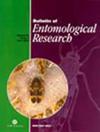First report of the association between Wolbachia and Cotesia flavipes (Hymenoptera: Braconidae): effect on life history parameters of the parasitoid
IF 1.6
3区 农林科学
Q2 ENTOMOLOGY
引用次数: 0
Abstract
The symbiosis between microorganisms and host arthropods can cause biological, physiological, and reproductive changes in the host population. The present study aimed to survey facultative symbionts of the genera首次报告 Wolbachia 与 Cotesia flavipes(膜翅目:蝙蝠科)之间的关联:对寄生虫生活史参数的影响
微生物与宿主节肢动物之间的共生关系可导致宿主种群的生物、生理和繁殖发生变化。本研究旨在实验室中调查 Cotesia flavipes (Cameron) (膜翅目:喙科) 和 Diatraea saccharalis (Fabricius) (鳞翅目:栉水母科) 的 Wolbachia、Arsenophonus、Cardinium、Rickettsia 和 Nosema 属的兼性共生体,并评估感染对这些宿主的适应性的影响。为此,使用 16S rDNA 引物检测宿主物种中的这些兼性共生菌,并评估宿主的生物和形态特征是否因这些微生物的感染而发生变化。在分析的 D. saccharalis 样品中没有检测到本文研究的细菌共生体,但在 C. flavipes 中检测到了内共生体 Wolbachia,并改变了这种寄生昆虫的生物学和形态学特征。这项研究的结果可能有助于阐明 Wolbachia 在维持黄蜂种群/品系质量方面的作用。
本文章由计算机程序翻译,如有差异,请以英文原文为准。
求助全文
约1分钟内获得全文
求助全文
来源期刊
CiteScore
4.00
自引率
0.00%
发文量
160
审稿时长
6-12 weeks
期刊介绍:
Established in 1910, the internationally recognised Bulletin of Entomological Research aims to further global knowledge of entomology through the generalisation of research findings rather than providing more entomological exceptions. The Bulletin publishes high quality and original research papers, ''critiques'' and review articles concerning insects or other arthropods of economic importance in agriculture, forestry, stored products, biological control, medicine, animal health and natural resource management. The scope of papers addresses the biology, ecology, behaviour, physiology and systematics of individuals and populations, with a particular emphasis upon the major current and emerging pests of agriculture, horticulture and forestry, and vectors of human and animal diseases. This includes the interactions between species (plants, hosts for parasites, natural enemies and whole communities), novel methodological developments, including molecular biology, in an applied context. The Bulletin does not publish the results of pesticide testing or traditional taxonomic revisions.

 求助内容:
求助内容: 应助结果提醒方式:
应助结果提醒方式:


